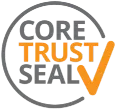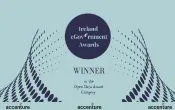Our third #DRI10 blog reflects on the publication of ‘Dublin Core and the Digital Repository of Ireland’, our first guidelines on preparing metadata for ingestion to the Repository.
The Digital Repository of Ireland (DRI) was formed ten years ago in September 2011. It was originally funded through a PRTLI (Programme for Research in Third-Level Institutions) Cycle 5 funding grant. In this phase (2011-2015), DRI was built by a research consortium of six academic partners. It was officially launched in June 2015 and continues to be managed by three core academic institutions – Royal Irish Academy, Trinity College Dublin, and Maynooth University. To mark our ten-year anniversary, DRI staff members are writing a blog a week focusing on different DRI milestones achieved over the past ten years. This is the third blog in the #DRI10 celebratory blog series.
In 2015, the Digital Repository of Ireland (DRI) published ‘Dublin Core and the Digital Repository of Ireland’ (most recent version here), our first guidelines on preparing metadata for ingestion to the Repository. This was the first in a series of metadata guides that also included recommendations for ingesting MODS (Metadata Object Description Schema), MARC (machine-readable cataloging) XML and EAD (Encoded Archival Description).
As described in a previous blog in this series, a major step in the development of the DRI was engagement with stakeholders around the country, culminating in our report, Digital Archiving in Ireland: National Survey of the Humanities and Social Sciences.
Taking account of academic libraries and cultural institutions, schools of social research, the community and voluntary sector, as well as the commercial and industrial sector, this report identified the four metadata standards above as the most widely used within the humanities and social sciences in Ireland.
Our subsequent guidelines on each of these standards were not intended to replace or modify the standard schemas, but to aid cataloguers in selecting which metadata elements to include, and to advise on the application of standardised formats and vocabularies to data that would be deposited in the DRI.
Dublin Core (named after Dublin, Ohio where the schema originated in 1995) was selected as the first of our guidelines not just because of its wide use in Irish institutions, but also because of its broad applicability. A general and flexible metadata standard, Dublin Core (DC) allows for the description of a variety of different resource types, which is an important consideration for an Humanities and Social Sciences (HSS) repository ingesting digitised cultural resources in a variety of textual, image-based and audio/visual formats.
DC is also widely supported by a variety of content management systems and open-access tools, making it relatively straightforward to export and cross-walk from other standards.
DC also supports the use of standardised vocabularies within each of its fields, allowing users to provide greater standardisation and searchability to their collections.
The original DC elements are:
- Contributor – An entity responsible for making contributions to the resource.
- Coverage – The spatial or temporal topic of the resource, the spatial applicability of the resource, or the jurisdiction under which the resource is relevant.
- Creator – An entity primarily responsible for making the resource.
- Date – A point or period of time associated with an event in the lifecycle of the resource.
- Description – An account of the resource.
- Format – The file format, physical medium, or dimensions of the resource.
- Identifier – An unambiguous reference to the resource within a given context.
- Language – A language of the resource.
- Publisher – An entity responsible for making the resource available.
- Relation – A related resource.
- Rights – Information about rights held in and over the resource.
- Source – A related resource from which the described resource is derived.
- Subject – The topic of the resource.
- Title – A name given to the resource.
- Type – The nature or genre of the resource.
Further information on DC elements can be found here.
Our original DC guidelines established a format that we followed for each of our subsequent DRI metadata guides:
- Inclusion of a sample DRI compliant record, and the current metadata schema.
- Recommendation of the one-to-one principle: DRI recommends that users are consistent in describing only the original object or its digitised version, but do not conflate the two within a DRI entry. For most digitised versions of historical materials, we generally recommend describing the original physical resource or previously published digital asset.
- A list of the mandatory and recommended elements of the standard which are supported by the DRI.
- For each element: the name of the element, the corresponding DRI label, a definition, format (e.g. free text), and example value.
Today, DC is by far the most widely used standard employed within the Repository. The DRI now supports the bulk ingest of prepared metadata in XML format and provides a metadata template with column headings based on DC elements. We also allow users to enter their data directly into our system through our user form. While the user form has ‘normal’ human-readable field headings and is ideal for first-time cataloguers less familiar with XML, the background metadata created by our system is fully compliant and exportable DC.
Since that initial publication, we have published two updated versions of the guidelines to reflect improved Repository services such as support for ORCID Researcher Identifiers, and advice for information to include when aggregating to Europeana. We have also published guidelines for Qualified Dublin Core (DCMI Metadata Terms ), a more complex version of the standard that supports modifiers and refining elements for the original set.
Coming full circle from our original stakeholder survey, the DRI Metadata Taskforce is currently undertaking a survey of our members to establish their current metadata practice to ensure we continue to support the most used standards in Ireland.
Kevin Long, Digital Archivist




